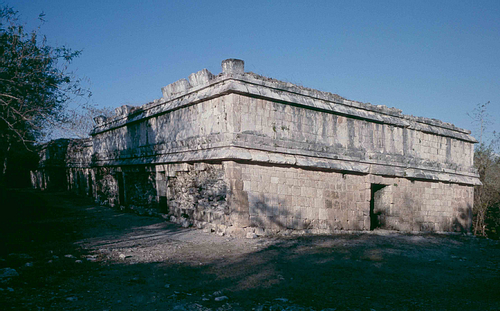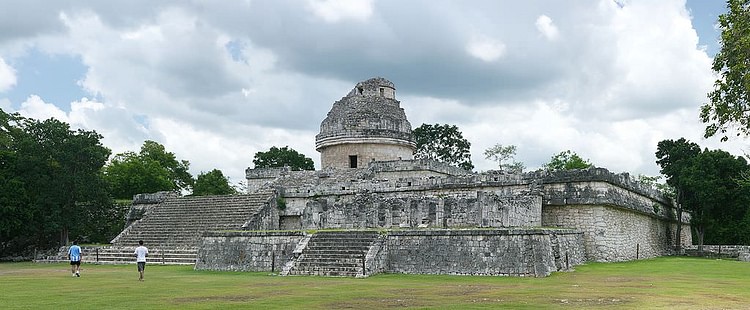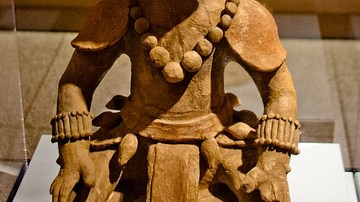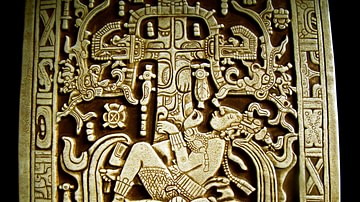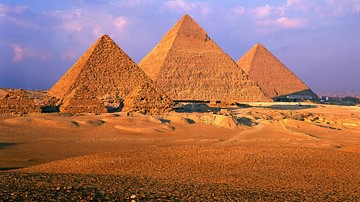Joshua J. Mark goes looking for adventure while visiting the Maya site of Chichen Itza in Mexico and finds sprites, spirits and iguanas amongst the ruins. He tells of his journey to this magical ancient site that has become a symbol of the Maya civilisation.
The small bus bumped along the uneven roads of Tinum in Yucatan, Mexico. I was sitting next to my guide, Isidro, heading toward an ancient city I'd been reading about for years but had never seen: Chichen Itza. Isidro and I passed the time with small talk as the squat bus rolled on beneath overhanging palm trees and the alternating sunlight and shade.

“Hey, would you happen to have a flashlight on you?” I asked.
“Why would you need one?”
“Well,” I said. “I'd like to get inside the Akab Dzib and I think I'll need a light.”
Isidro shook his head, looking out at the road. He said, “You don't want to go in there. It is protected by the Ushmals.” I shrugged.
“The Ushmals,” he said. “They are like your fairies or – sprites? They are mischevious little beings. They call the Akab Dzib their home.”
He then went on to describe the Ushmals (also known as Aluxoob or Duende), how they often appeared as miniature people and had potent powers over human beings. He said how one should never say their name out loud in an open space or attract their attention or else they could follow one home and even inhabit a person's mind. He didn't say any of this as though it were superstition or fable. They didn't sound like a lot of fun. Even with his warning I was still intent to enter the Akab Dzib and asked if it was possible to get inside.
“It is closed to the public. You may see the outside,” he said, and then added, “Why didn't you bring a flashlight if you were planning on sneaking into the Akab Dzib?”
“I had four,” I said. “But I have this habit of crawling into old ruins and this morning Betsy – my wife – took my flashlights out of my backpack. She thought I'd maybe think twice on this trip without them.” Isidro smiled and nodded, saying,
“I see. Your Betsy is very wise. I will have to keep an eye on you.”
We drove on. The trip from Playa del Carmen to Chichen Itza is about two hours, one-way. Once you leave the resort area you hit the main roads which wind across the country with cars zipping quickly past, the sounds of horns, stretches of faded fields and faraway trees on either side of the dusty highway. The main roads, though, slowly begin to turn into smaller, narrower ones and soon you're driving beneath thick, overhanging trees and passing by small villages and white-washed homes where, Isidro told me, the people live very like their ancestors did a thousand years ago. Isidro is Maya, as are the people whose homes we passed, and he told me how funny he finds it when he reads magazines or books from the United States, which talk about the 'mysterious Maya', and how they all disappeared. He said, “As you can see, no one has gone anywhere. We are all still here as we have always been.”

The Maya are the indigenous people of the region who lived in magnificent cities and outlying villages in Mexico and Central America and who continue to live in the same areas as their ancestors: modern-day Yucatan, Quintana Roo, Campeche, Tabasco, and Chiapas in Mexico and southward through Guatemala, Belize, El Salvador and Honduras. Their name, Maya, comes from the ancient Yucatan city of Mayapan, the last capital of a Maya Kingdom in the Post-Classic Period.
Little was known of the Maya until the mid-nineteenth century when John Lloyd Stephens and Frederic Catherwood explored the region and brought back reports of fantastic cities of immense height and scope buried in the jungles of Mexico and Central America. Stephen's book, Incidents of Travel in Central America, Chiapas, and Yucatan, published in 1841 CE, created world-wide interest in the Maya; so much so that many wealthy Americans sought Maya art or pieces of architecture for their estates. One man, John C. Cruger, had portions of Maya ruins brought to his island on the Hudson River in New York and, when he found he didn't have enough, hired artisans to create fake ones.
Between roughly 200-950 CE (known as the El-Tajin Period and the Classic Maya Period) the Maya lived in their great cities, built their enigmatic monuments, and engaged in warfare and trade with each other and then, in a relatively brief period of time, the cities were abandoned. No one knows why. By the time of the Spanish Conquest in the sixteenth century, cities like Chichen Itza, Uxmal, Tikal, and Bonampak were already deserted ruins.
The Spanish priests did not at first believe that the people they found living in huts in the jungle were responsible for the enormous empty cities which rose from the tangle of growth. Most likely, the cities were abandoned due to overuse of the land and depletion of water supplies. The city of Copan, to cite only one example, was abandoned when the population outgrew the city's resources. This explanation was not available to the Spanish of the sixteenth century, however, and the cities appeared to them as evidence of some great lost civilization.
The new arrivals did little to try to understand the people or the buildings they encountered. They were more interested in converting the indigenous peoples to Christianity and transporting whatever they found of value back to Europe. The Spanish could not decipher the Maya glyphs and were in no way helped by one of their priests, the Bishop Diego de Landa, who burned the Maya books and thousands of statuary the night of 12 July 1562 CE in an effort to sever the link between the Maya and their 'satanic' beliefs.
De Landa holds an interesting place in Maya history since, although he destroyed much of the cultural artefacts which would have helped people to understand Maya history, he also left a comprehensive written account of the culture as he found it, which has proven valuable to later scholars and historians. Still his suppression and persecution of the Maya culture led the people to distrust the Christians who were so intent on saving them and they no longer shared with the immigrant conquerors any of the details of their culture.
This is most clearly demonstrated through the Maya holy book, The Popol Vuh, which states that the stories are being set down in a time of persecution by the Christians and the book must be kept secret. In their zeal to exploit the land and the people for their own gain, the European conquerors failed to understand the purpose of the art, literature or buildings they discovered.
Among these buildings was the mysterious structure known as the Akab Dzib which even today baffles archaeologists. The name Akab Dzib translates as 'House of the Mysterious Writing' and is so-called because of glyphs (writing) found inside which no one can translate and hand prints in red (similar to those at Tulum) which should symbolize the Descending God of the Maya but don't fit the usual pattern. The building, which is the oldest at Chichen Itza, had intrigued me since I'd first read about it years ago. I had read how it was inhabited by spirits but hadn't given that any thought until Isidro had talked about the Ushmals earlier. I wasn't especially interested in meeting any Ushmals but I did want to see the mysterious writing.
We rolled into Chichen Itza with the great pyramid of El Castillo (The Castle) rising up on our left and we parked in front of a very modern looking gift shop and café on our right. I wasn't interested in gifts or bathrooms and we went directly toward El Castillo where Isidro began his tour. He explained how the name Chichen Itza is often translated as something like 'The Mouth of the Well of the Itza' but actually means 'The City of the Well of the Water Wizards' because of the huge cenote (a large natural pool) which was a centre of religious rites and because the Itza (the wizards) had a great talent for gathering and preserving water; a gift highly prized by the Maya.

El Castillo is an immensely impressive structure, a step-pyramid rising high into the sky, carefully aligned with the heavens so that, at the spring and autumn equinoxes, a shadow is cast on the stairs which appears to be the great plumed serpent god Kukulkan descending down to touch his people. The steps are short and narrow, even though long across, and hard to climb - especially if one has a fear of heights. There was a thin rope strung up the centre of the stairs to act as a handrail but it wasn't of much use.
The illusion of stability it offered, however, proved more and more valuable the higher one climbed. From the top of El Castillo the view is absolutely astounding as the jungle spreads out beneath you for miles. At the time the city was inhabited none of the trees one gazes down upon existed and the whole of the city - and far beyond - would have been laid out clearly at the feet of the ancient priests and rulers who would have stood where I was standing.
Going up the steps of El Castillo, however anxiety-inducing I'd found it, was infinitely easier than going down. Going up, one can keep one's gaze focused on each step as one climbs; going down, there is no way to block out how high up you are or how narrow each step is and that flimsy rope handrail seemed as useful as an umbrella in a hurricane. When I reached the bottom I was ready for a drink and some shade but there was too much city to explore and we moved on.
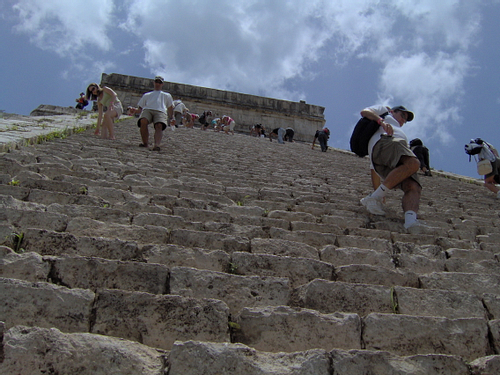
The Great Ball Court nearby is so perfectly constructed that when Isidro whispered “Where are you?” from one end, 500 feet away from me, I could hear him clearly as though he were standing beside me. No one, he told me, has ever been able to explain this phenomenon. Various experts have studied the architecture of the ball court to try to replicate the acoustics elsewhere but none have succeeded. The ball court was once where the Maya played their game of Poc-a-Toc, a ball game with deep spiritual resonance. The two teams of seven men faced each other on the field and tried to score by getting a small, hard, rubber ball through a vertical stone hoop set some twenty feet (or higher) above the ground using only their hips, shoulders, head, and knees; one could not kick or throw the ball.
De Landa wrote that watching the Maya play Poc-a-Toc was like seeing lightning strikes, they moved so fast. The game symbolized the harmonious circle of life and re-enacted the game played by the Hero Twins of Maya religion, Hun-Hunapu and Xbalanque, who defeated the Lords of Xibalba and created the ordered world. It has long been argued by western historians that the losing team was sacrificed to the gods but Isidro - and others I spoke with later - claimed it was the winning team and only under certain circumstances.
As Isidro pointed out, “The gods would not be interested in having losers play for them; they only want the best. And the teams, they would have been grateful - whether winning or losing. We should always be grateful, in all things, always.” It was a line he repeated, with variations, as we walked through the city's ruins. Gratitude, he said, was a very important value to his people, as was hospitality.
Everywhere we went, everywhere I looked, all around the grounds of the city, were Maya selling wares spread out on colourful blankets or simply sitting on the grass surrounded by small statues or jewellery for sale. I overheard some tourists complaining that they shouldn't let these people on to the grounds to annoy visitors; they didn't seem to consider that Chichen Itza was built by the ancestors of these people they were disrespecting who were only smiling and welcoming them. Those who were selling their goods were all very polite, not at all intrusive or bothersome. They seemed to be simply offering souvenirs for sale in an outdoor market, much as their ancestors would have done, and a visitor could buy or decline at their pleasure.

We left the city centre and visited the sacred Cenote, which I found to be a very moving experience as I'd read that people were willingly sacrificed at this spot to ensure the health of the community through continued rainfall and a strong harvest. Isidro confirmed this saying how the offerings to the gods were probably not captives from other cities, who would have been sacrificed in a different way, but people from the community who gave their lives for the well-being of the city.
The Cenote is not a short walk from El Castillo and, by the time we got back there, pausing by the fascinating Tzompantli (a thick platform adorned with skulls), we were both hot and tired. Isidro suggested that it was time for a break and a cool drink but I had other plans: the Akab Dzib. He said that he was going to rest awhile and speak with some friends he saw over by the gift shop but that I could go if I wished. As I was walking away he called out, “Remember what I said about that place. Don't go inside. If you see a rope across the door, stay out.”
The day was hotter than before but it was a dry heat. I passed through sparse woods, stopped at the amazing Caracol, the ancient observatory, and went on, the leaves and pebbles softly crunching beneath my sandals. The further away I got from the site's centre the quieter everything became until all I heard were the sounds of birds in the trees around me and small scampering in the dirt and grass of iguanas which would sometimes run out in front of me seeking a shady spot. And then there, in a clearing before me, stood the Akab Dzib.
It was a small building, maybe only twenty feet high, built of short, sturdy-looking limestone bricks and running over a hundred feet in length. Grass and small trees grew from its roof and around the foundation and the whole structure seemed completely organic; as though it had grown up from the ground with the plants and trees which surrounded and topped it. There was one door in the building in front of me with a low-lying pale yellow rope across it. I had read there were seven doors in the Akab Dzib but that the room with the strange writing was at the southern end. I had lost all sense of direction so I hoped I was at the right end. I easily stepped over the rope, which hung maybe an inch off the ground and couldn't possibly have been placed there to keep anyone out, and walked into the darkness of the building.
I'd expected it to be cooler out of the sun, but it felt hot and stale inside; the air was thick and dried my mouth and tongue. I may not have had my flashlight but I did have a small Bic lighter, and flicking it, I saw that I was standing in an ancient hallway, a doorway ahead of me. Light came through from the door behind me and I moved ahead, my sandals scattering the dry earth and the thick air seeming to cling to me as I moved slowly down the hallway - when I heard a sound. Something was moving in the darkness ahead of me, moving slowly.
I could hear the gravel stirring and something rousing itself in the soft sandy soil. I stepped forward and the sound came again but this time it seemed closer. Suddenly Isidro's warnings of the Ushmals were all I could think of; how they protected their shelters, how they could change shape at will, how frightening they could be. I had my lighter in hand and sunlight from the door behind me but it was still dark and dim ahead of me and I took a step back. Then the 'something' ahead of me moved quickly. It sounded large. It sounded huge. The small rocks and earth beneath it were skittering against the stones of the wall and I turned and started to run back the way I'd come, stumbled out the door, felt my foot catch on something, and then went sailing through the air to land heavily on the gravel outside.
Quickly, I scurried onto my back and then was up and glaring at the doorway and that stupid rope I'd just tripped over - and there stood my assailant: an iguana. It wasn't even a very large iguana. I'd crawled into ruins with snakes in them larger than that thing. I noticed I'd managed to cut my knees when I fell and scraped the palms of my hands on the gravel. I pulled out my watch and saw I'd spent more time at the Caracol than I'd intended and more time creeping down the hallway than I'd thought and I had to get back to Isidro.
I hadn't seen any mysterious writing above the doorway when I'd gone in, so I knew I'd been at the wrong end. I walked quickly around the Akab Dzib and stood at the southern doorway, but I just didn't feel like going in. Yes, an iguana had scared me off my quest. I figured that, if that little guy was in there, someone else probably was also and I wasn't wearing the best foot or leg wear, in just a T-shirt, shorts and sandals, for an encounter with a snake like the fer-de-lance (also known as the Terciopelo) or maybe a sprite like an Ushmal. I looked at the rope hanging across the door, this one about knee-high, and turned away.
When I got back to Isidro he looked at my scratched knees, dusty T-shirt and arms, and said, “You went in anyway, didn't you?
”I said, “Not far. Got chased out by an iguana.”
“That iguana,” he said. “He did you a great favour.” I just nodded and shrugged.
We continued touring Chichen Itza and every building, every engraved stele, seemed more magnificent than the last. The Temple of the Warriors and Group of a Thousand Columns were incredibly exciting to walk among and Isidro's narrative of the history of the city and the people brought everything vibrantly to life.
We left Chichen Itza as the tour buses began to arrive and the crowds flowed in. In nearby Piste, we stopped and had lunch at a cafe which was owned by Isidro's friends. That cold Sol beer was one of the best I'd ever tasted and the food was excellent: hot spanish rice and tamales, gorditas and Menudo Rojo.
After our meal, we headed back toward Carmen del Playa, talking about the day as we drove. I never got to see the strange writings inside the Akab Dzib but, somehow, it didn't matter to me anymore. Walking through the ruins with Isidro I felt as though I'd travelled back to the time of the water wizards when the city was alive with his ancestors and the buildings and columns gleamed brightly painted in the sun.
The spirit of the place was so resonant I could almost feel the collective past of centuries at my fingertips on the ride home. When we reached Playa del Carmen the memory of the sunlight and shade of the woods around the Akab Dzib and the steep steps of El Castillo were vividly before my eyes as I thanked Isidro for the day and headed back to tell Betsy about my adventure.
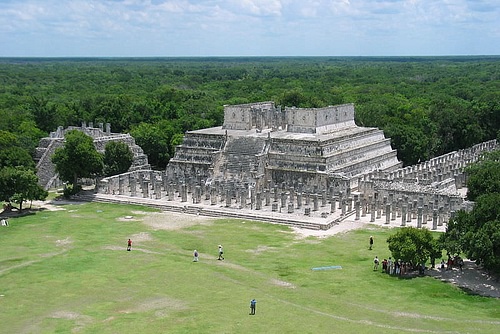
I highly recommend a visit to Chichen Itza and, if you go, encourage you to hire a guide. There is too much you'll miss without one. Guides may be hired at the resorts of Playa del Carmen and there are also guided tour buses which leave from the area by the beach in the early morning and, further, guides one may hire at the site.
I'd also encourage you to watch out for those iguanas. I think I could deal with being chased out of the Akab Dzib by an angry Ushmal, no problem, but a little iguana? That's just embarrassing. Of course, according to Isidro, that iguana was just protecting me from myself and, as with everything, I should only be grateful for the experience.


